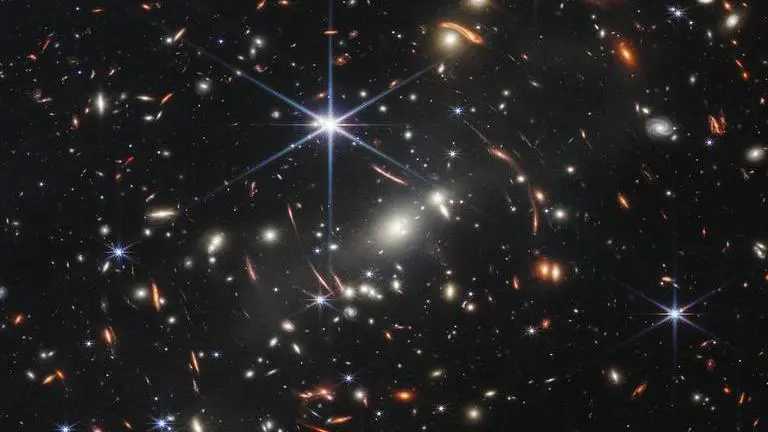Updated 12 July 2022 at 07:12 IST
NASA's James Webb Space Telescope captures first 'deepest' view of ancient galaxies
NASA has unveiled the first image of the sharpest view of galaxies as they were 13 billion years ago, captured by what was deemed as the most powerful telescope
- Science News
- 3 min read

In a historic first, NASA has unveiled the first image of the sharpest view of galaxies as they were 13 billion years ago, captured by what was deemed as the most powerful telescope that was ever launched into space. James Webb space telescope (JWST), which NASA has promised to reshape humankind’s understanding of the universe, captured a small slice of outer space, named SMACS 0723.
The first James Webb image, in detail, shows the light from several different shining galaxies in the oldest universe. The picture was approved and unveiled by US President Joe Biden at a White House event and he called the moment “historic”. US President said that SMACS 0723 provides “a new window into the history of our universe”. According to him, “it’s hard to even fathom”.
Biden said, “It’s astounding. It’s an historic moment for science and technology, for America and all of humanity.”
The NASA administrator, Bill Nelson explained that the extraordinary image showed the light of the galaxies bending around other galaxies, travelling for billions of years before it finally reached the James Webb telescope. Noting that NASA is planning on “almost” going back to the beginning of the universe, Nelson said that with SMACS 0723, “We are looking back more than 13 billion years”. He revealed that the United States space agency will be uncovering several other images captured by its advanced telescope to around 13.5 billion years.
“We are going back almost to the beginning,” he said.
It's here–the deepest, sharpest infrared view of the universe to date: Webb's First Deep Field.
— NASA (@NASA) July 11, 2022
Previewed by @POTUS on July 11, it shows galaxies once invisible to us. The full set of @NASAWebb's first full-color images & data will be revealed July 12: https://t.co/63zxpNDi4I pic.twitter.com/zAr7YoFZ8C
The first image from the Webb Space Telescope represents a historic moment for science and technology. For astronomy and space exploration.
— President Biden (@POTUS) July 11, 2022
And for America and all humanity. pic.twitter.com/cI2UUQcQXj
SMACS 0723: What does it show?
What according to NASA is “overflowing detail” of the first image captured by James Webb, are thousands of galaxies which include even the “faintest objects” that were ever observed in the infrared but have now appeared in telescope's view. NASA noted, “This slice of the vast universe covers a patch of sky approximately the size of a grain of sand held at arm’s length by someone on the ground.”
Advertisement
It is to note here that the “deep field”, captured by the telescope, is an amalgamation of pictures at different wavelengths, totalling 12.5 hours and achieving the depths at infrared wavelengths beyond the deepest fields of the agency’s other famous telescope, Hubble Space.
The US space agency has further elaborated that the galaxy cluster, named SMACS 0723, is where the universe appeared at least 4.6 billion years ago. The first James Webb image would allow NASA researchers to soon start learning more about the galaxies, masses, ages, histories and compositions. While Biden released the first-fill colour image, the agency said that the full suite will be released on Tuesday, July 12.
Advertisement
Image: NASA, ESA, CSA, and STScI
Published By : Aanchal Nigam
Published On: 12 July 2022 at 07:12 IST
